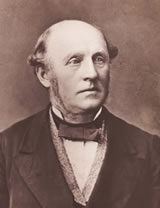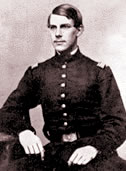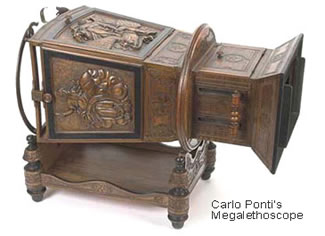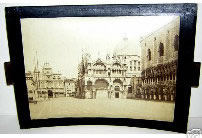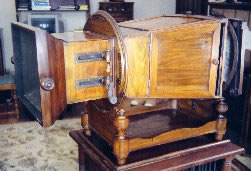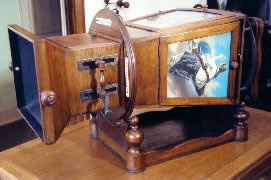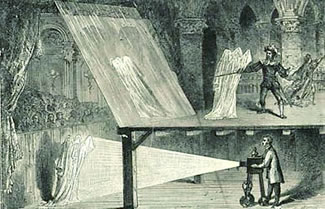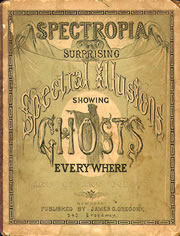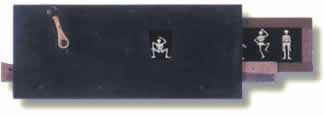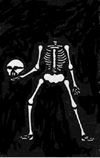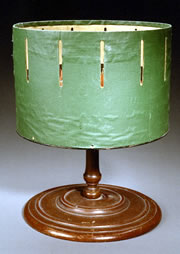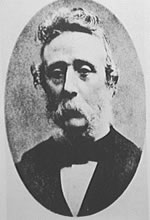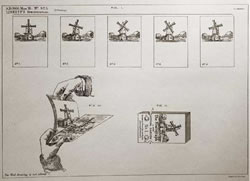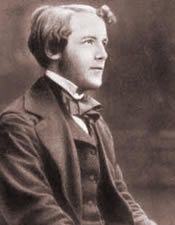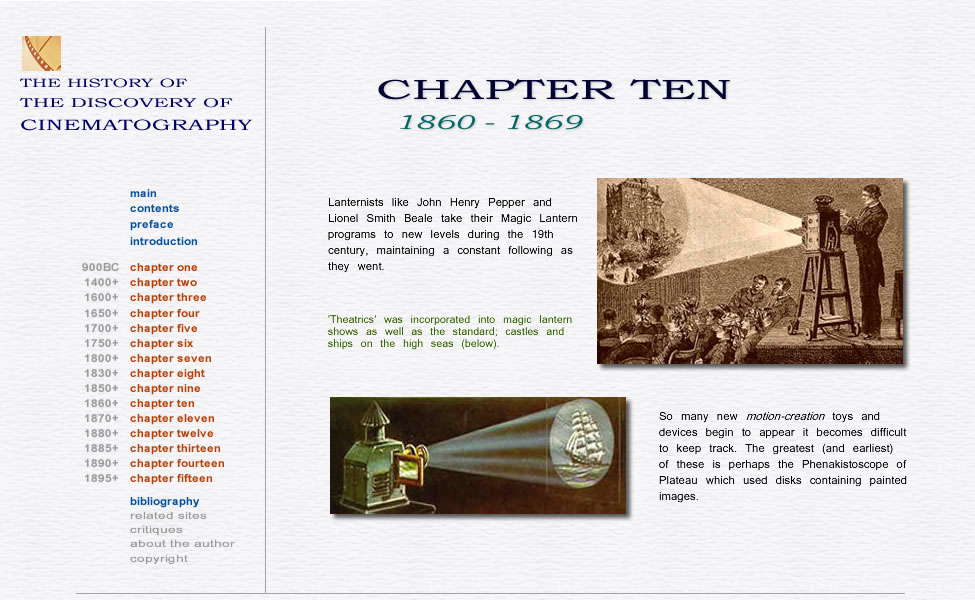 |
|||||||||||||||||||||||||
| 1860 THOMAS ROSE ( - ) |
|||||||||||||||||||||||||
| Suggested that a 3D moving picture could be achieved through the use of the Phenakistoscope by using 100 cameras taking Stereoscopic Pictures. | |||||||||||||||||||||||||
| 1860 PIERRE HUBERT DESVIGNES ( - ) |
|||||||||||||||||||||||||
| Desvignes designs a system that suggests the use of an endless stream of film as well as Stereoscopic Photographs in motion. His device was in the vein of the Zoetrope however Desvignes did not name it. He also instigated the use of models for recapturing motion, as did Muybridge and Marey. The Zoetrope was invented by Horner and later copied by Lincoln. | |||||||||||||||||||||||||
| 1860 THOMAS HOOMAN DU MONT ( ) |
|||||||||||||||||||||||||
| Although he never builds it, Du Mont designed on paper, a camera, which he believed, was capable of photographing motion. | |||||||||||||||||||||||||
| 1861 WILLIAM THOMAS SHAW ( - ) |
|||||||||||||||||||||||||
| Shaw constructs an eight-sided drum housing Stereoscopic Photographs, and views them through the Stereoscope by Wheatstone. Shaw's device is known as the Stereostrope. | |||||||||||||||||||||||||
|
|||||||||||||||||||||||||
|
|||||||||||||||||||||||||
|
|||||||||||||||||||||||||
| 1861 THOMAS HOOMAN DU MONT ( - ) |
|||||||||||||||||||||||||
| This Frenchman of whom we have little substantial documentation, apparently came up with a process by which he could photograph action naturally either in humans or animals. The process was developed into a camera whereby Du Mont geared a shutter to expose plates once they became perpendicular to the axis of the lens. The writer/historian Olive Cook in her book ‚€˜Movement In Two Dimensions‚€™ [Hutchinson, London, 1963] documents the cine-camera as . . . . . ‚€œThe sensitive surfaces succeeded one another at regular intervals, being placed either on a prismatic drum or sliding frame, or else dropped in turn from an upper chamber into a lower one.‚€Ě (p131). | |||||||||||||||||||||||||
| 1861 COLEMAN SELLERS (1827 - 1902) |
|||||||||||||||||||||||||
| Sellers obtains a patent in the U.S. for his Kinematoscope. This was a children's motion-recreation toy utilizing a wheel with paddle-action showing posed photographs. This gadget was also known briefly, as the Motoscope. Sellers posed his children working in his factory in Philadelphia, for the photographs. His photographs were stereoscopically produced in a double-lensed camera. The term ‚€˜cinema‚€™ comes from ‚€˜Kinema‚€™-toscope and is derived from the Greek word kinema-matos meaning the science of pure motion. Sellers was quite the distinguished and honoured scientist, engineer and inventor. He was appointed professor of mechanics at the Franklin Institute in 1881, earned the standing of non-resident professor of engineering at the Stevens Institute of Technology in 1888, honoured with the order of St. Olaf by the King of Sweden in 1877 and many other degrees and honours. Since his childhood Sellers was knowledgeable in the art of sleight-of-hand. Between 1861-1863 he was a member and correspondent of the British Journal of Photography. | |||||||||||||||||||||||||
| AUTHOR'S NOTE: We believe it important to note that up until the work of Marey and Muybridge (1872), pictures used for the purpose of motion recreation, where all drawings or photographic-type transparencies of posed motion. Even though Plateau suggested using photographs in their place in 1848, it took another 24 years before happening. Muybridge especially with his work in stop-action series photography ultimately paved the way for photographs to finally be used (over 50 years after their discovery) in the formation of moving pictures. Then, subjects did not have to be still or even pose as still. They could move freely and be captured as moving, and then presented as if captured that way. | |||||||||||||||||||||||||
|
|||||||||||||||||||||||||
Image
Source (above 3): The James Weber Collection |
|||||||||||||||||||||||||
| 1862 -1863 JOHN HENRY PEPPER (1821 - 1900) and HENRY DIRCKS (1806 - 1873) |
|||||||||||||||||||||||||
| Combining a little of theatrical magic and a magic lantern show is the work of Dircks and Pepper. The final outcome - Pepper's Ghost. As the story goes, an engineer from Liverpool named Henry Dircks created a model of an apparatus capable in theory of projecting a life-like ghost onto a stage before an audience. As Thomas Weynants has correctly pointed out, this 'appearance' of a ghost-like projection was in fact the "illuminating [of] a real actor, dressed as a ghost" (Weynants, Early Visual Media / Pre Cinema / The Ghost in the Theatre: Pepper's Ghost Effect). Enter John Henry Pepper, a chemist from London who takes it a step further; building a practical working model for use in the theatre. Pepper's Ghost was presented as a three-dimensional transparent sensation in 1863. Utilizing one sheet of stationary glass angled to 45 degrees along with accurate and sensitive lighting, Pepper's Ghost shocked audiences then, and has continued to be used in plays, television and films up to this day. Back projection as it was (and still is) known by lanternist's, is called The Shuftan Process in film. It has been incorporated by Hitchcock, Disney and Coppola, and used in films like A Christmas Carol (Dickens), MacBeth and Hamlet. | |||||||||||||||||||||||||
|
|||||||||||||||||||||||||
| 1864 - SPECTRAL ILLUSIONS | |||||||||||||||||||||||||
|
|||||||||||||||||||||||||
| Image Source: Optical Toys | |||||||||||||||||||||||||
| 1864 LOUIS ARTHUR DUCOS DU HAURON (1837 - 1920) |
|||||||||||||||||||||||||
| Designs and patents a motion picture photographing projection system in France for ‚€œan apparatus designed to reproduce by photography any scenes, with all the transformations undergone during a predetermined time.‚€Ě It appears from research completed, that Hauron never actually produced the thing in a physical sense. In the patent forms, Hauron gave us only a vision when he stated; | |||||||||||||||||||||||||
| ‚€œMy invention consists in substituting rapidly and without confusion to the eye, not only of an individual but when so desired a whole assemblage, the enlarged images of a great number of pictures when taken instantaneously and successively at very short intervals . . . . . The observer will believe that he sees only one image, which changes gradually by reason of the successive changes of form and position of the objects which occur from one picture to the other. Even supposing that there be a slight interval of time during which the same object was not shown, the persistence of the luminous impression upon the eye will fill this gap. There will be as it were a living representation of nature and the same scene will be reproduced upon the screen with the same degree of animation . . . . . By means of my apparatus I am enabled especially to reproduce the passing of a procession, a review of military maneuvers, the movements of a battle, a public fete, a theatrical scene . . . . . . ‚€œ | |||||||||||||||||||||||||
| What we do know about Hauron‚€™s patent is found in #61976, March 1864, when we read where his thinking was taking him. In it, we see that he suggested; using the camera and projector in slow motion, time-lapse photography, magnified images, mounting successive images on a band of either paper or some fabric (as in Celluloid), using the camera in a moving vehicle as a pan or moving dolly shot, and instant pictures taken rapidly. Du Hauron had described motion pictures. | |||||||||||||||||||||||||
| 1865 JAMES LAING ( - ) |
|||||||||||||||||||||||||
| Laing designs the Motorscope, something similar to that of Shaw's Stereostrope. Few details are known. | |||||||||||||||||||||||||
| 1865 A. MOLTENI ( - ) |
|||||||||||||||||||||||||
| Invents a machine he calls a Choreutoscope Tournant, using an intermittent movement similar to that of Armat (1897). | |||||||||||||||||||||||||
|
|||||||||||||||||||||||||
| Illumination for this toy is simple daylight however it can be held before another source such as a lamp, on the slide-side of the device. A shutter closed in between images, keeping unwanted light from the view opening. To see a working Chorentoscope using Adobe Flash, go to The Getty Museum's Devices Of Wonder. Choose the Chorentoscope image in the lower right corner and see this optical device as it would have (and still does) appear. | |||||||||||||||||||||||||
| AUTHOR'S NOTE: Ceram, on page 24 of Archeology states that Beale projected drawn pictures with his Chorentoscope or Choreutoscope in 1866. My research also suggests that this event may have happened in 1872 as Quigley states (p172 of Magic Shadows). Both men however agree that Beale accomplished this in England. Still mysterious is the entry directly above this, where Quigley on the same page states the Choreutoscope is that of Molteni. These two entries [ MOLTENI 1865 "Choreutoscope Tournant, using an intermittent movement similar to that of Armat (1897)" AND BEALE 1866 ] are interesting because of the similarity in dates, names of device and the description of each. Both Ceram and Quigley are quoted as saying these (or this) machine(s) had the Maltese Cross intermittent movement mechanism, and both are off only by one year. No other research has uncovered what the truth of the matter may be. SEE 1872 BEALE and 1897 ARMAT. | |||||||||||||||||||||||||
| 1866 EADWEARD JAMES MUYBRIDGE (1830 - 1904) |
|||||||||||||||||||||||||
| Born as Edward James Muggeridge, Muybridge sails to the United States in 1852 and opens a bookstore in San Francisco shortly thereafter. After a head injury and recuperation period in England, he sailed to America again and began photographing western landmarks. One such series of photographs was of the Yosemite Valley, which he sold under the pseudonym Helios, The Flying Camera (Helios being Greek for Sun). Muybridge would become a major player in the story of the discovery of motion pictures. Muybridge's first photographs were taken using the Wet-Collodion process. | |||||||||||||||||||||||||
|
|||||||||||||||||||||||||
| 1867 ALFRED POLLOCK ( - ) |
|||||||||||||||||||||||||
| This photographer suggested the reproduction of movement through the use of Plateau's Phenakistoscope. He stated that if photographs were taken of a man walking and then mounted on a disk, "the image might walk at the same pace as the subject had done." | |||||||||||||||||||||||||
| 1868 JOHN WESLEY HYATT ( - ) |
|||||||||||||||||||||||||
| Hyatt begins studies in the formation of what will become known as Celluloid. An improved version to that of Parkes whose product was plastic-based. Hyatt‚€™s flexi-based invention combines camphor and collodion. He is issued a patent for this product. | |||||||||||||||||||||||||
|
|||||||||||||||||||||||||
| 1868 LOUIS ARTHUR DUCOS DU HAURON (1837 - 1920) |
|||||||||||||||||||||||||
| Produces a photograph with three colours and is granted a patent for the process. Du Hauron used different filters to photograph his scenes and then printed the negatives on thin sheets of bichromated gelatin. The plates contained carbon pigments of red, blue, and yellow. He publishes Les Couleurs en Photographie, describing subtractive colour photography. | |||||||||||||||||||||||||
|
|||||||||||||||||||||||||
Drawing
(above) of a booklet of windmill images in Linnett's 1868 Kineograph
patent |
|||||||||||||||||||||||||
| 1869 A. B. BROWN ( - ) |
|||||||||||||||||||||||||
| Brings the projector of Uchatius to the U. S. and patents it. Uchatius‚€™ Lantern Wheel of Light and Plateaus‚€™ Phenakistoscope being quite similar in design and use, Brown incorporated into the machine a Maltese Cross arrangement and shutter, essential to the completion of cinematography as we know it today. This ensured the intermittent movement required between frames. | |||||||||||||||||||||||||
|
|||||||||||||||||||||||||

|
|||||||||||||||||||||||||
